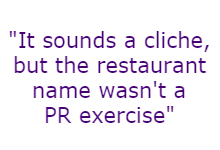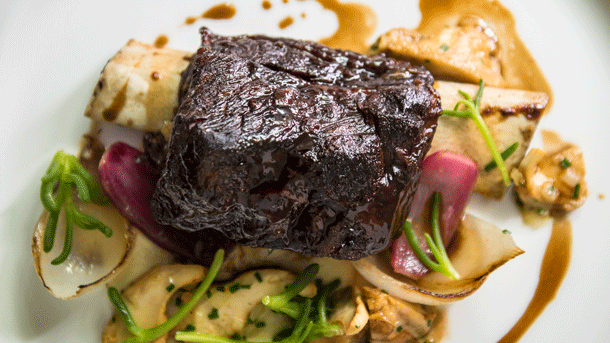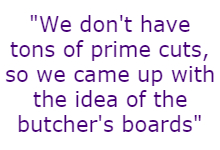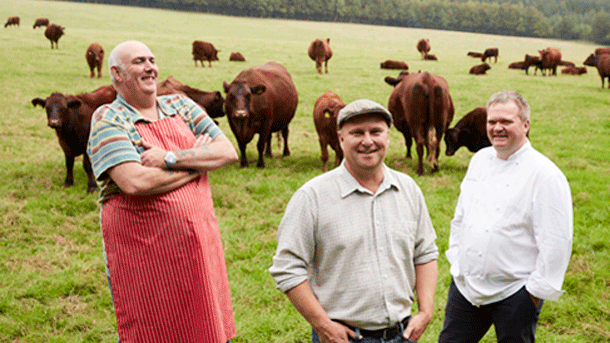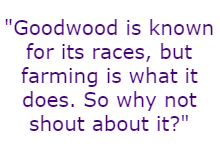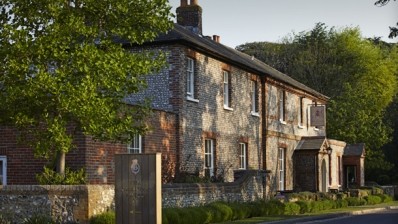FEATURE
From fast cars to slow food: why Goodwood is building on its organic farming heritage with a new restaurant
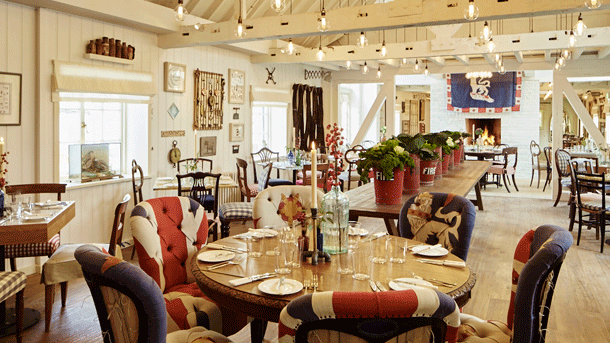
Say it to the locals of Chichester, home of Goodwood, meanwhile, and it will evoke images of heavy traffic on event days, the arrival of drunk, overdressed people in the town in the evening and the annual fly-by of the Red Arrows. And golf.
What neither camp will mention in the same breath as Goodwood, however, is food, despite the fact that the estate is not only home to three restaurants and a café, but also Home Farm, a 3,400-acre organic farm on which the estate’s own beef cattle, pigs and lambs are reared.
The 12,000-acre estate also produces its own milk and cheese, and puts its name to a lager and an ale. Grounds for arguing that horse and car racing is little more than a sideline.
Yet this lack of reputation for food could finally soon change with the opening last month of the restaurant Farmer, Butcher, Chef, which Goodwood owner Lord March and executive chef Darron Bunn believe could help finally put the estate on the map for more than outdoor pursuits.
Replacing The Richmond Arms – a restaurant that was primarily part of the Goodwood House Hotel to service breakfast and which wasn’t open for lunch – Farmer, Butcher, Chef will instead function as a destination restaurant that puts the organic produce from its estate centre stage.
From cars to carcasses
The transition from racing cars to organic farming is actually not a new one. South African former racing driver Jody Scheckter now owns the successful Laverstock Park, 2,500 acres of bio-dynamic and organic farming in Hampshire. With almost 1,000 more acres of farmland than Laverstock, Goodwood is well placed to reap similar rewards.
“There has long been talk that change needed to happen at Goodwood and that it was in need of a new identity, but we didn’t know what that identity was for a time,” says Bunn, who joined the company a year ago having been introduced to the farm’s wares by the Royal Academy of Culinary Arts.
“I’d heard of Goodwood because of the races but I didn’t know it had a commercial farm and certainly didn’t know about the rest of what goes on here,” he says. “The answer was there all along. Farming is what Goodwood does, so why not shout about it?”
According to Bunn, Goodwood’s restaurants, including The Bar & Grill next to its health club and the dining room at members’ only club The Kennels, have in the past tried to showcase the farm’s produce but never on one menu.
This is where Farmer, Butcher, Chef is different in that in takes a nose-to-tail approach to its meat and the whole menu is dictated by the produce available from the farm each week.
This is not without its challenges. Home Farm processes just three cows, 12 pigs and 25 lambs every week for the entire estate, meaning that prime cuts are a scarcity. “If we get eight sirloins a week then The Kennels will have them,” says Bunn. “If it’s rib eye, they’ll go to The Bar & Grill, while fillets are shared between them.
Private members expect to see steak and chips on the menu. In order to not nick everything from the other restaurants, we needed to offer something else.”
Meaty menu: beef short-rib
This is where the name comes in. “It sounds like a bit of a cliché but the name of this restaurant wasn’t a PR exercise,” insists Bunn. “We’ll write a menu then take it to John [Hearn, the estate’s master butcher] and sit down with him and he’ll say whether we can use this particular cut or not and then make some suggestions. We know our way around an animal but we’re not butchers.”
Hearn and Bunn also meet with Tim Hassell, the farmer in the equation, every Friday, to get to grips with which animals will be available. The fact that the farmer and butcher are directly involved in designing dishes according to what cuts are available, rather than the other way around, means that nothing is wasted.
The weekly conversations help Bunn and the kitchen team devise menus and overcome problems that the tight supply of meat can bring. For example, Bunn says he wanted to put a braised ox cheek dish on the menu, but with only three cows available each week this was out of the question. On talking with Hearn, however, he discovered that he could instead use a v-cut of shin that would have similar eating qualities to cheek in terms of flavour and texture.
The other way the restaurant has circumnavigated the issue of supply is with its butcher’s boards that feature prime cuts sitting cheek-by-jowl, as it were, with cheaper cuts of meat. “The butcher’s boards are what the restaurant is all about,” says Bunn. “We’re in a position where we don’t have tons of prime cuts of anything because of the amount of animals that we process each week, so it would be wrong to have sirloin on the menu because we don’t have enough of it.
"That’s part of the joy of the restaurant but it is a problem too as people expect you to have prime pieces of meat on the menu, they don’t want it all to be tongue and cheek. We came up with the idea of the butcher’s boards so that they contain many different parts of the animal cooked in different ways. If we sell 30 of them in a night, we are not going to have to take them off the menu the next day.”
Three boards are on the launch menu in lamb, pork and beef, each priced at £20 per person.
The lamb option, for example, includes rack, braised shoulder hot pot, devilled liver and heart, and rosemary-cured lamb belly while the beef board features skirt steak, sticky beef short rib, oxtail faggot, crusted shin and crispy tongue.
“The restaurant is a great place to showcase Goodwood’s stuff. I don’t know any chef who wouldn’t get excited about serving this kind
of food,” says Bunn.
Animal magic
Having its own farm means that Goodwood has extremely tight controls over the quality of its meat, not just in terms of butchery and ageing, but in the breeds it uses. Its 400-strong herd of beef cattle are deep-red Sussex and feed on clover and grass grown on the estate.
The best heifers are served in rotation by two Sussex bulls and their female calves are then cross bred with the unrelated bull to produce animals with a long straight back that gives high quality cuts of meat. All beef is hung for at least 28 days.
The slow-growing nature of the animals and their tight supply means that the majority of its beef is used by the estate, either in the restaurants or sold as burgers and joints in its farm shop, although it does sell a small amount to some London restaurants.
John Williams at The Ritz is a fan, and he puts it on his menu when there is availability, as does Sky Garden restaurant atop the Walkie Talkie.
Holy trinity: butcher John Hearn, farmer Tim Hassell and chef Darron Bunn
Lamb comes from Southdown sheep and the estate’s pork from sows that are a mixture of two traditional breeds: Gloucester Old Spot and Saddleback, which are crossed with a Large White breed of boar to create hardy outdoor breeds that thrive at the farm. “The white boar provides shape and conformity,” says Hassell. “With Old Spots and Saddlebacks you can sometimes get a bit too much fat so it enables us to get more uniformity with our bacon and roasting joints.”
Both the Southdown lamb and Sussex cattle breeds have been farmed on Goodwood land on and off for centuries, which is why they were reintroduced when the estate most recently started farming again.
Home Farm gained organic accreditation for its meat in 1996 (its dairy was certified organic in 2002) and both breeds are ideal for organic production, says Hassell. “We wanted to bring back the traditional breeds. They naturally feed off the grass and chalkland downs and are very hardy. The Sussex needs less food than some of the better-known beef cattle breeds but still gives exceptional quality meat.”
Game is another feature of the estate, and appears on the Farmer, Butcher, Chef menu when in season, although it is the only meat that is not processed on site. The restaurant will make use of the abundance of wild deer that roam the estate and of its pheasants but uses a game dealer who takes the animals and guarantees that what is returned is Goodwood stock.
Bunn says he will also serve “the odd rabbit and hare when in season” but admits that supply of either is limited.
Even the cheeseboard at the restaurant – or most of it at least as it does permit some ‘interlopers’ – is made within a cow’s moo of the dining room. Home Farm’s herd of 200 milking cows are part-Shorthorns, a breed that originated in the 16th century and which was the best milking cow of its time, according to Goodwood.
The diary herd produces 21,000 litres of non-homogenised milk a week, some of which is used to make cheese.
Three are currently produced, Charlton ‘cheddar’, Molecomb Blue and a creamy white bloom rinded soft cheese called Levin Down (named after the escarpment in the Sussex Downs viewed from the Goodwood Estate), which are sold to shops in London and the south-east as well as in the restaurants.
Organic growth of a brand
While Laverstock Park in Hampshire and Daylesford Organic in the Cotswolds have created successful organic produce brands as well as, in Daylesford’s case, a number of restaurants and cafés across the country, Goodwood has been slower on the uptake even though Home Farm was one the first 100% organically fed dairies in the country and is one of the largest lowland organic farms in the UK.
So why has the estate taken so long to realise the full potential of its farm? It has primarily been down to controlling the whole meat process, from farming to butchery, and then getting in chefs with the required skills, says Hassell.
Hearn was drafted in three years ago to start the in-house butchery, and with Bunn now as executive chef, only recently has the estate had the expertise required to take a nose-to-tail approach to cooking at its restaurants.
“We’ve always had the quality behind the scenes but it is only since we got the butchers involved that we got total control of our meat,” says Hassell. “When I started selling our beef to London restaurants, people on the estate realised I was telling the truth about the quality of our meat and that we could do more with it.”
Now the team is in place, Goodwood could yet become known as much for its pigs and cows as it is its horses. “The Richmond Arms was a function space. With Farmer, Butcher, Chef we have created very much a restaurant with rooms,” says Bunn. “A lot of people come to Goodwood and the food is incidental. We are now trying to create a reason for them to come because of the food.”
